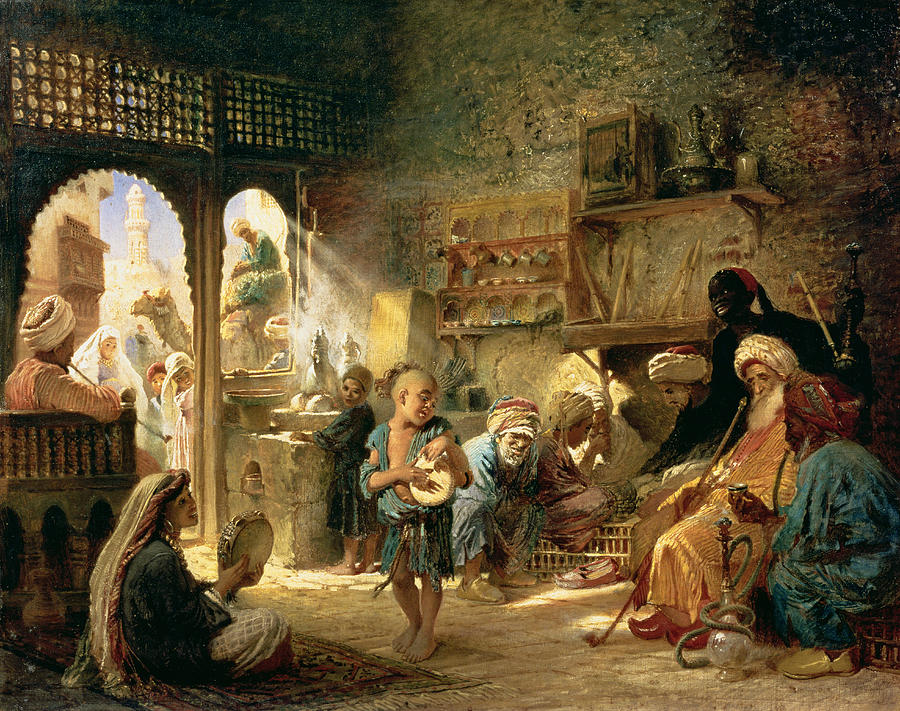What are the legends about the origin of coffee? Telling stories from legend to history
Professional barista communication, please pay attention to coffee workshop (Weixin Official Accounts cafe_style)
The story of coffee goes back generations, spanning more than 1000 years, and like so many events on Earth, it is still shrouded in fog. The story of coffee is the journey of a brown seed, full of mystery and wonder.
Every time we drink coffee, we are immersed in a world that has fascinated bards and literati since time immemorial. The earliest legends about coffee are believed to have come from the East in 400 BC.

The Legend of Coffee
Although European and Arab historians have collected many mysterious oral stories that originated in the kingdom of the Queen of Siba in Africa before 500 AD, the only surviving written records are that coffee was a well-known plant in the first half of the 15th century and people drank coffee. In his first monograph on coffee, De Saluberrima potione (1671), Friar Antonio Fausto Naironi recounted the legend of Kaldi, the Ethiopian shepherd. One night Cody's flock didn't come back from the pasture, so he went out to look for it. The next day he found them bouncing around munching on beans near a clump of tender green bushes full of bright red fruit. Curious by the strange behavior of the sheep, the shepherd tasted the wild fruit and found it highly exciting. Cody therefore embarked on a long journey to Chehodet Monastery in Yemen, at the southern tip of the Arabian Peninsula, to inform the monks of his discovery. A priest said,"This is the devil's work!" He threw these red fruits into the fire, and the fruits immediately emitted a special aroma that made people drool. They then collected the beans, ground them into powder and poured them into containers filled with hot water, and the world's first cup of coffee was made. The monks found that the bitter dark drink kept them awake in prayer. Word of the magical effects of this delicious drink spread among monasteries, and coffee began to be regarded as a true gift from heaven.

Cafe in Cairo, 1870s by Konstantin Egorovich Makovsky
The legend of Muhammad is perhaps less well known. One day the prophet suddenly felt drowsy, and the archangel Gabriel came to his aid and gave him a potion given by Allah himself. Muhammad drank it and felt refreshed and resumed his great work. In this legend, the drink, which is as dark as the Holy Black Stone of the Kaaba, is called gahwah, indicating that it is of plant origin.
Coffee's long journey has since begun in Africa, but the road is still long. In the 13th century, slaves from Sudan to Arabia gathered coffee berries in Ethiopia, believing they would help them tide over difficulties. Perhaps that's how coffee beans first crossed the Red Sea and spread around the world.
In Middle Eastern countries, coffee is considered medicinal, and caffeine-rich concoctions were originally drunk as soups, but later became daily drinks.
According to Islamic folklore, Sheikh Omar was the first Arab to discover coffee and make coffee beans into a drink. A doctor and cleric, he was exiled with his followers to the desert region of Assab for violating ethical norms. Omar and his companions gathered wild berries from unknown bushes to stave off hunger, boiled them and drank the juice. They say they got the idea from a dream. Omar had patients who followed him into the desert to continue their treatment, and the plant must have helped them. When the exiles returned home to Mocha, they told others about the magical properties of the new drink. The locals built a temple in memory of Omar and honored him as the patron saint of the city.

A Sufi dancer in a 16th century pocket painting. The 13th century enigma al-Shadhili was the first to make coffee beans into a drink. Shazri's followers and descendants are Sufi believers, and their ritual use of coffee (for example, during the famous whirl dance) is frowned upon by other more orthodox sects, as Islam prohibits the use of any substance that "provokes excitement." Sufi mystics use coffee as a pick-me-up to engage themselves in unusually long prayer rituals, during which they achieve a state of religious ecstasy.
In addition, Sufi believers (dervishes living in the Yemen desert region of southern Arabia) are said to be familiar with this refreshing drink. They celebrate the glory of God in religious ceremonies, sometimes lasting more than 700 nights, and drink coffee to stay awake during these long gatherings. Devout believers also enjoyed coffee with friends during the day and enjoyed the refreshing effects of caffeine, and the first cafes were born.

the history of coffee
Only one thing is reasonably certain, and that is that coffee trees are native to Ethiopia, originating in Abyssinian Kaffa and growing in the wonderful coffee forests at altitudes of 900 to 2000 meters. The ancestors of the Galla, a nomadic mountain people living in Ethiopia's bustling Sidamo province, were well aware of the refreshing effects of coffee beans. They mash coffee beans and mix them with animal fat to make some kind of energy tonic.

Legend of the shepherd Cody; parchment, Addis Ababa, Ethiopia.
In the early sixteenth century coffee began to spread from the monasteries of Yemen to the major cities (Cairo first), attracting enthusiasts from all walks of life. This "black drink" was so popular that around 1523 Turkish marriage contracts even included a clause stating that the husband must ensure that his wife has a proper amount of coffee to drink and that violators must divorce.
The Arabs had long struggled to maintain their monopoly on the coffee trade, but it was impossible to keep tabs on the millions of pilgrims who made the pilgrimage to Mecca each year. One of them was named Baba. Pilgrims in Baba Budan swallowed seven red fruits in 1670 and planted them on their farmland in the Chandragiri Hills of Karnataka, South India. The planting was so successful that the area was renamed Baba in his honor. He was appointed to the post of Chief of Staff of the Ministry of Finance and the Ministry of Finance, in recognition of his contribution to the prosperity of his hometown. This moment also symbolizes the end of the era of Yemen and Arabic monopoly coffee market.
Dutch traders, who had been exporting goods from Africa and Asia since the early seventeenth century (incense, sandalwood, silk, etc.), quickly understood the potential of this new commodity and were eager to make coffee cultivation more widespread. By the 18th century, under the rule of European powers, all areas suitable for growing coffee began to grow coffee. The world's first coffee plantations sprang up in equatorial regions, in addition to Ceylon and Java, but also in Sumatra, Celebes, Timor and Bali.

A branch of a coffee bush; illustration, in a herbarium, dated c. 1800.
Of all the stories, perhaps the most romantic is the introduction of coffee to Martinique. It all started in the early 18th century when the Dutch presented a robust coffee tree to the French government. It is said that Captain Gabriel? Dee? Gabriel de Clieu was determined to transport this precious plant safely from France to Martinique, and so kindly distributed the ship's daily ration of water to the plant he cared for, so that the sapling could survive the long journey safely.
Captain Dee Crewe introduced coffee cultivation to the French colonies around 1723. Most coffee trees in the world today probably trace their origins back to that sapling.
Coffee soon became a highly prized commodity that people desperately wanted. In 1727, the French of Guyana had a dispute with Dutch colonists, and Francisco de Melo Palheta, a Portugal, was called in to arbitrate. He stole some coffee beans, which were in high demand at the time. But in the end, his trick succeeded because of the love of a woman. On the day he set out for home, his mistress sent him a large bouquet of flowers, mixed with bright fruits. He planted these fruits in Pará, Brazil, and became the first coffee producer on the global market.
Important Notice :
前街咖啡 FrontStreet Coffee has moved to new addredd:
FrontStreet Coffee Address: 315,Donghua East Road,GuangZhou
Tel:020 38364473
- Prev

Have a cup of iced coffee. Introduction to Japanese coffee culture.
For professional baristas, please follow the coffee workshop (official Wechat account cafe_style) if you want to drink coffee in Japan, you can go to convenience stores, "Blue Bottle Coffee" and other third-wave coffee shops and tea shops. Iced coffee is a unique Japanese drink. This article will introduce the unique coffee culture of Japan. Blue Bottle Coffee marched into Japan. Summary of Japanese Coffee
- Next

Nordic baking is a very light baking style
About Double Roasting, Light Roasting and High Roasting Nordic Roasting Among these many baking methods, we specially select Double Roasting, Light Roasting and High Roasting to introduce you. Let's talk about double baking first. Some people call it second baking, and literally, we can explain it very clearly, the first time we bake the beans, we bake the beans over low heat until
Related
- How did the Salvadoran coffee industry develop in Central America?
- What exactly does the golden cup extraction of coffee mean?
- The Origin of Coffee flower
- [2023 Starbucks World Earth Day] there are more meaningful things besides free Starbucks coffee!
- What kind of coffee is there in Spain? 9 Flavors of Spanish Coffee
- Aromatic African coffee| Kenya's coffee culture and historical production area
- Liberica Coffee Bean knowledge: the characteristics of Liberian Coffee beans of the three original species of Coffee beans
- The origin and formula of Spanish latte introduces the taste characteristics of Bombon coffee in Valencia, Spain.
- How to adjust the solution of over-extracted coffee
- What is the tasting period of coffee beans? What is the period of coffee and beans? How should coffee wake up and raise beans?

